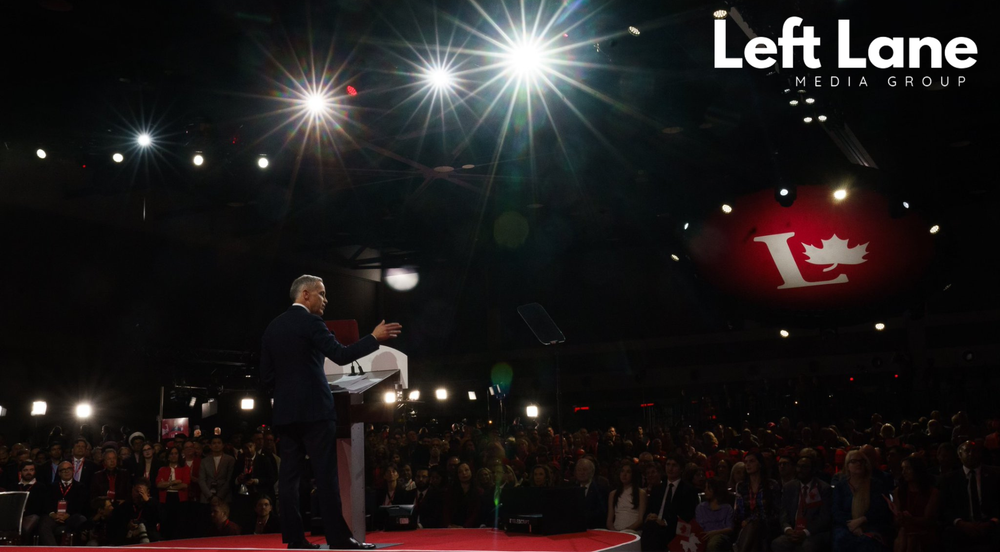ADAMS: While Poilievre and Singh Rant, Common Sense Carney Builds
Canadian Prime Minister Mark Carney delivers a speech during the Liberal leadership race, addressing party supporters. Photo credit: @MarkJCarney on X
Few politicians have ever risen as fast or as unexpectedly as Mark Carney. Just months ago, he was an outsider in the Liberal leadership race. Now, he’s Prime Minister—and in his first act, he’s already overturned the consumer carbon tax. But it’s his government’s bold new housing plan that has everyone talking.
Last week, the Liberals announced a promise to build nearly 500,000 homes per year and create a new federal housing agency. The Conservatives saw this coming, but they were powerless to stop it. That’s not for lack of trying: painting him as an out-of-touch banker, attacking his time in the UK, even questioning if he was ‘too elite’ to connect with everyday Canadians. None of it stuck. Because where Poilievre relied on anger and Singh and Blanchet leaned on ideals, Carney offered something different: competence.
For years, Canadians have been frustrated with sky-high prices, endless red tape, and governments unable or unwilling to fix the problem. The Trudeau government and the Harper government before it largely failed to tackle the crisis, Poilievre blamed municipal ‘gatekeepers,’ and Singh called for even more government spending. Carney, however, came in with a plan both ambitious and pragmatic.
Instead of ideological posturing, he’s delivered policy that combines market incentives with government action—a balance that neither Singh nor Poilievre has managed to strike.
Build Canada Homes

Build Canada Homes, outlined in a newly released 2-page platform document has one purpose: get the federal government back into the business of building homes. BCH will develop and manage affordable housing on public land, take over key programs from the Canada Mortgage and Housing Corporation (CMHC), and invest billions to supercharge construction of prefabricated and modular houses, reduce emissions, and create good-paying jobs, while also providing $10 billion in low-cost financing and clear homelessness targets. BCH will also cut red tape, revive proven tax incentives, and help convert existing buildings into homes. The goal? Double homebuilding to 500,000 units a year.
With Build Canada Homes, Carney has drawn a clear line in the sand: you're either serious about solving the housing crisis, or you're just talking. When you stack this plan up against what Jagmeet Singh and Pierre Poilievre are offering, the difference isn’t just in policy; it’s in political seriousness. One is bringing solutions. The others are bringing slogans.
The Carney Liberals housing plan proves that the leadership of Pierre Poilievre has been a complete failure for the Conservative Party, their platform is outdated and they have made no real effort to modernize its 2022 platform. All Poilievre has offered is slogans and angry social media posts, without a real commitment to federal building, or any sort of path to building even half the amount of houses Carney is promising. Poilievre talks demolition; Carney talks construction.
Jagmeet Singh and the NDP on the other hand, have focused mostly on corporate landlords, with an added emphasis on social housing and co-ops. Addressing these problems is an excellent goal, but where Singh falls flat is his limited scope. Most of Singh's proposals are not obtainable without a federal structure like BCH, and the NDP missed a huge opportunity to propose anything close to BCH’s ambition. Singh diagnosed the problem, but Carney is prescribing the cure.
Mark Carney’s proposal to double home construction over the next decade with Build Canada Homes (BCH) sends a clear message: he’s serious about solving the housing crisis, and he has a plan to do it. If Carney can deliver, he won’t just fix one of Canada’s most pressing challenges; he’ll set a new standard for leadership. While Poilievre yells and Singh dreams, Carney builds. And in a country that’s hungry for results more than ever, that might be exactly the kind of leadership Canada needs.
This piece was written by an individual contributor and reflects the editorial position of The Provincial Times and Left Lane Media Group. Read our Content Policy here.




